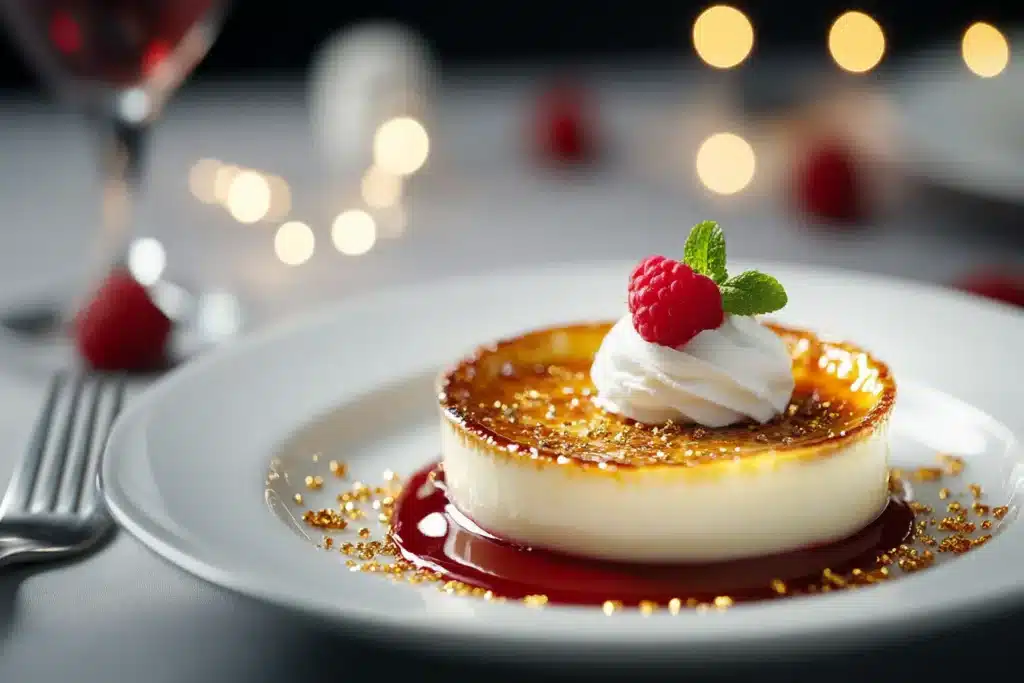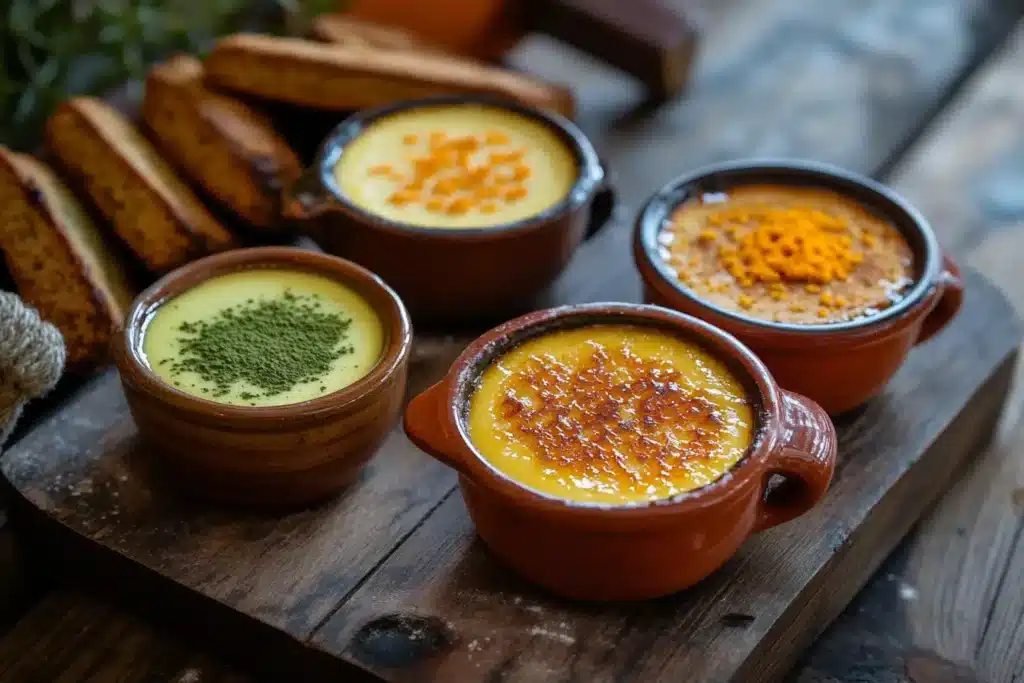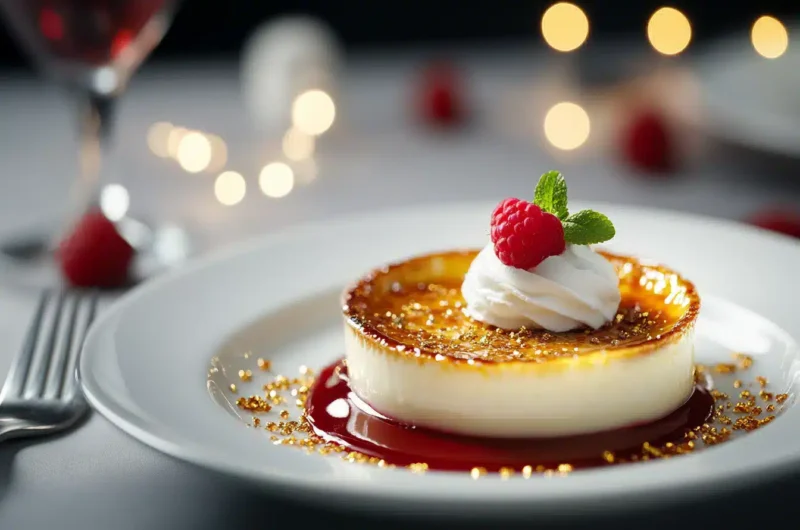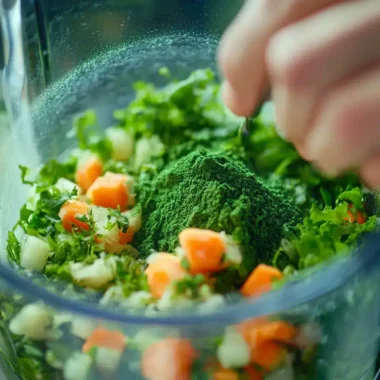Crème brûlée, often hailed as a culinary masterpiece, is as fascinating in its flavor as it is in its journey across the globe. With its velvety custard base and caramelized sugar crust, this French dessert has captured hearts worldwide. But where exactly is this burnt cream served? From charming French bistros to modern eateries in bustling cities, the dessert’s presence is as diverse as it is delicious.
In this article, we’ll explore the origins of crème brûlée, delve into its traditional serving practices, and take a global tour of where it’s celebrated. Along the way, we’ll uncover fascinating twists and modern interpretations. Let’s crack the caramelized top and discover where crème brûlée truly shines!

Understanding Crème Brûlée
1.1 Definition and Components
Crème brûlée, directly translated as “burnt cream,” is a dessert that combines simplicity with elegance. It consists of a rich custard base flavored with vanilla and topped with a layer of caramelized sugar. This classic French dessert is not only known for its luxurious taste but also for the satisfying crack of its sugary crust. The custard’s smooth texture, juxtaposed with the crunch of the topping, creates a sensory delight.
1.2 Historical Origins
The origins of crème brûlée have long been debated. Some culinary historians trace its roots back to France, while others suggest it was inspired by similar desserts in Spain or England. For instance, the Spanish crema catalana and the English Trinity cream share striking similarities with crème brûlée, leading to intriguing discussions about which dessert truly came first.
Interestingly, its first written mention was in a French cookbook in 1691, cementing its association with French cuisine. Over centuries, it has evolved from an aristocratic treat to a globally beloved dessert.
1.3 Evolution Over Time
Crème brûlée’s transformation reflects its adaptability. Traditionally served in ramekins, it was once a dessert reserved for the elite. Today, its availability ranges from Michelin-starred restaurants to casual cafes, and even home kitchens. The introduction of culinary torches revolutionized the preparation process, making it easier to achieve the iconic caramel crust.
Moreover, regional twists—such as infused flavors like lavender, matcha, or chocolate—have kept crème brûlée relevant, adding new dimensions to its timeless appeal.
Traditional Serving Practices
2.1 Serving Temperature of Crème Brûlée
When it comes to serving crème brûlée, the ideal temperature plays a crucial role in enhancing its texture and flavor. Traditionally, this dessert is served slightly chilled, which allows the rich custard base to maintain its creamy consistency while contrasting with the warm, caramelized sugar layer. While some might think of it as a warm dessert because of the torching process, it’s crucial to let the custard cool properly before serving. This delicate balance ensures that every bite feels luxurious and well-composed.
Interestingly, serving crème brûlée at the wrong temperature—either too warm or too cold—can diminish its iconic taste. For example, overly chilled custard becomes dense, whereas a warm base might feel too soft, losing its signature contrast. That’s why in restaurants, chefs carefully monitor this detail to deliver the perfect dessert experience.
2.2 Impact on Texture and Flavor
The interplay of temperature doesn’t just influence how crème brûlée feels on the palate; it also elevates the flavors. The chilled custard base enhances the natural sweetness of the vanilla and cream, while the crunchy, caramelized sugar provides a smoky depth. Together, they create a delightful contrast that’s both complex and comforting.
For those who prepare crème brûlée at home, the texture is just as important as flavor. Ensuring the custard is baked gently in a water bath—then cooled—helps achieve that silky smooth consistency. Adding the caramelized sugar right before serving ensures that the topping retains its crunch and doesn’t dissolve into the custard.
3.1 Classic Ramekins
The serving vessel plays a significant role in how crème brûlée is presented and enjoyed. Traditionally, crème brûlée is served in shallow, white ramekins that highlight its visual appeal and allow the caramelized sugar topping to be evenly distributed. These ramekins are not only functional but also elegant, emphasizing the dessert’s sophisticated nature.
Ramekins also provide practical benefits. Their shallow design ensures the custard cooks evenly in the oven, preventing over- or undercooked spots. Additionally, they allow for consistent caramelization, making it easier for chefs to achieve the perfect crunch in every bite.
3.2 Alternative Vessels
While ramekins are the standard, many modern chefs experiment with creative serving options to elevate the dining experience. For instance, some restaurants serve crème brûlée in mini cast-iron skillets, which add a rustic charm. Others use transparent glass dishes to showcase the layers of custard and caramel.
In some contemporary settings, crème brûlée is even presented in edible vessels, such as chocolate cups or hollowed-out fruits like oranges. These innovations not only enhance the visual appeal but also provide an unexpected twist, allowing diners to enjoy the dessert in new and exciting ways.
Global Presence of Crème Brûlée
4. Crème Brûlée in French Cuisine
Crème brûlée is a quintessential French dessert, and its connection to France is as deep as its flavor is rich. Across the country, it is served in a variety of settings, from quaint countryside bistros to world-renowned Michelin-starred restaurants.
4.1 Prominent French Restaurants Serving Crème Brûlée
In France, crème brûlée holds a cherished place on dessert menus. Restaurants like Le Meurice in Paris and regional gems such as Lyon’s bouchons often treat this dessert with the reverence it deserves. The French believe that the quality of the custard and the perfection of the caramelization are markers of a chef’s skill. Therefore, it is not surprising to see crème brûlée served as a highlight in both fine dining establishments and cozy, traditional settings.
4.2 Regional Variations in France
While the classic vanilla-flavored version is most prevalent, certain regions in France have created their own twists on crème brûlée. For instance, Provence incorporates lavender, offering an aromatic variation that complements the dessert’s creamy profile. In Brittany, the use of salted caramel in place of the sugar topping showcases the region’s renowned expertise in caramel confections. These regional adaptations not only celebrate local ingredients but also keep the tradition of crème brûlée alive and evolving.
5. Crème Brûlée in European Countries

Though its roots are firmly planted in France, crème brûlée has found a welcoming audience in other European countries. Its adaptability and elegance have allowed it to become a sought-after dessert across the continent.
5.1 United Kingdom
In the UK, crème brûlée often appears on menus in both upscale restaurants and traditional pubs, celebrated for its simplicity and indulgence. While the classic version remains popular, British chefs sometimes experiment with flavors such as rhubarb or even Earl Grey tea, reflecting the country’s culinary creativity.
5.2 Spain
Spain’s crema catalana is often compared to crème brûlée, as both share similar ingredients and preparation methods. However, crème brûlée is still served in many Spanish restaurants, especially those with French-inspired menus. The subtle differences between the two desserts—such as the use of citrus zest in crema catalana—often spark interesting comparisons among diners.
5.3 Italy
In Italy, crème brûlée finds a place alongside other custard-based desserts, such as panna cotta. Italian chefs occasionally incorporate local ingredients like Amaretto or pistachio into their versions, offering a uniquely Italian take on the French classic. Served in elegant dishes, it often competes with tiramisu for the spotlight on dessert menus.
Crème Brûlée in North America and Asia
6. Crème Brûlée in North America
Crème brûlée made its way to North America as French culinary techniques gained popularity. Today, it is a go-to dessert in high-end restaurants and is even featured in some trendy casual eateries.
6.1 United States
In the United States, crème brûlée is synonymous with luxury. It is commonly served at steakhouses, fine dining restaurants, and wedding receptions. American chefs, known for their innovative approaches, often infuse the dessert with unique flavors like bourbon vanilla, pumpkin spice, or maple. Furthermore, cities like New York and San Francisco are known for offering the most imaginative takes on this classic treat.
6.2 Canada
In Canada, crème brûlée is equally beloved. With a culinary scene heavily influenced by French traditions, it’s no surprise that crème brûlée is a staple dessert in both Quebec and beyond. Many Canadian restaurants incorporate local ingredients, such as maple syrup, to create a distinctly Canadian version of this French favorite.
7. Crème Brûlée in Asia
Asia’s embrace of crème brûlée has been a fascinating journey. While the dessert’s origins are foreign, its flavors and textures align perfectly with the Asian palate, making it a hit in countries across the region.
7.1 Japan
Japan’s love for delicate, refined flavors has made crème brûlée a standout dessert in its patisseries and fusion restaurants. Japanese chefs often incorporate matcha (green tea) or yuzu (a citrus fruit) into the custard, resulting in variations that are as artistic as they are flavorful. Additionally, the presentation is typically minimalist, reflecting Japanese aesthetics.
7.2 China
In China, crème brûlée is often served in upscale restaurants and hotels catering to Western tastes. However, local adaptations, such as infusions of jasmine tea or lychee, add a unique twist. This blend of East meets West allows crème brûlée to resonate with Chinese diners while maintaining its French charm.
Modern Interpretations and Variations
9. Flavor Innovations
Crème brûlée, while rooted in tradition, has become a canvas for creative experimentation in recent years. Chefs worldwide have reimagined its flavors to cater to diverse palates, blending classic elements with bold, contemporary twists.
9.1 Infused Flavors
One of the most exciting developments in the world of crème brûlée is the infusion of new flavors. For instance, chefs often add matcha, lavender, or even chai spices to the custard, creating unique versions that still honor the dessert’s essence. These flavors not only appeal to modern tastes but also introduce elements of surprise, making each bite unforgettable. Additionally, the use of tropical ingredients like coconut or passion fruit has given the dessert a refreshing edge.
What’s more, these innovative flavors often showcase local ingredients, allowing crème brûlée to seamlessly integrate into various culinary traditions. For example, in Southeast Asia, pandan leaf-infused crème brûlée has become a popular treat, combining familiar regional tastes with the dessert’s signature elegance.
9.2 Dietary Adaptations
Crème brûlée has also evolved to accommodate dietary preferences, ensuring it remains inclusive and accessible. Vegan versions, made with coconut milk or cashew cream, replicate the creamy texture of the original without using dairy. Similarly, sugar-free variations have gained popularity, catering to those who prefer low-carb desserts while maintaining the dessert’s indulgent appeal.
10. Contemporary Serving Methods
Presentation plays a vital role in how desserts are perceived, and crème brûlée is no exception. While its traditional ramekin presentation remains a classic, modern chefs have embraced innovative serving methods to elevate the dining experience.
10.1 Deconstructed Presentations
In contemporary fine dining, deconstructed crème brûlée has become a trend. Rather than serving the dessert in its usual form, chefs present its individual components—custard, caramelized sugar, and garnishes—separately on the plate. This not only adds visual drama but also invites diners to assemble and enjoy the dessert in their own way. It’s a fun, interactive twist that keeps the dish exciting.
10.2 Fusion with Other Desserts
Another modern approach involves blending crème brûlée with other beloved desserts. For example, crème brûlée-filled éclairs, donuts, or even macarons have made their way onto dessert menus. These fusions merge the creamy, caramelized essence of crème brûlée with other textures and flavors, creating a delightful hybrid that appeals to dessert lovers.
In some cases, chefs incorporate crème brûlée into cakes or tarts, layering the custard with sponge cake or fruit fillings. These adaptations showcase the dessert’s versatility and its ability to complement other culinary creations seamlessly.
Crème Brûlée in Popular Culture
11. Crème Brûlée in Media
Crème brûlée is not just a beloved dessert; it has also gained recognition in popular culture. Its elegant appearance and luxurious reputation have made it a star in movies, television, and even literature.
11.1 Film and Television
This dessert often symbolizes sophistication or romance in films and TV shows. For instance, scenes in upscale restaurants frequently showcase crème brûlée as a representation of indulgence. Characters may crack the caramelized sugar with a spoon, adding a visual and auditory element that enhances its allure. Shows focusing on culinary competitions also feature crème brûlée as a test of a chef’s technical skills, emphasizing its status as a challenging yet rewarding dessert.
11.2 Literature
In literature, crème brûlée often serves as a metaphor for elegance, complexity, or even nostalgia. Writers have used its contrasting textures—the smooth custard and the crisp caramelized topping—as a poetic device to symbolize life’s dualities. Additionally, books about French culture and cuisine frequently highlight crème brûlée as an iconic representation of France’s culinary artistry.
12. Crème Brûlée in Culinary Competitions
As a dish that requires precision and technique, crème brûlée often appears in culinary contests, showcasing its role as a benchmark for skill in dessert preparation.
12.1 Notable Appearances
Culinary shows like MasterChef or The Great British Bake Off regularly challenge contestants to create crème brûlée, testing their ability to balance flavor, texture, and presentation. Because of its deceptively simple ingredients, achieving the perfect custard consistency and caramelized sugar layer requires both expertise and creativity. Viewers often find these segments particularly engaging, as the process of torching the sugar adds a dramatic visual element.
12.2 Influence on Popularity
These appearances have significantly popularized crème brûlée worldwide. They inspire viewers to try making it at home, while restaurants boost the dish’s fame by adding it to their menus. In this way, culinary competitions actively sustain crème brûlée’s reputation as both a classic and contemporary dessert.
Part 7: Frequently Asked Questions
13. FAQs About Crème Brûlée
13.1 Is crème brûlée served hot or cold?
Crème brûlée is traditionally served chilled, but the caramelized sugar topping is slightly warm due to the torching process. This contrast between the cold custard and the warm topping is one of its defining characteristics, creating a delightful interplay of textures and temperatures.
13.2 What is the origin of crème brûlée?
Crème brûlée is often associated with French cuisine, but its exact origin is debated. Some believe it originated in France, while others point to similar desserts like Spain’s crema catalana or England’s Trinity cream. However, its first written recipe appeared in a French cookbook in 1691, solidifying its ties to French gastronomy.
13.3 What are common variations of crème brûlée?
While the classic vanilla-flavored custard is the most popular, there are many variations of crème brûlée. Infused flavors like matcha, lavender, or coffee are common, and regional ingredients such as pandan in Asia or maple in Canada add unique twists to the dessert.
13.4 How is the caramelized top of crème brûlée made?
The caramelized top is created by sprinkling sugar evenly over the custard and then using a torch to melt and caramelize the sugar. The result is a thin, crunchy layer that contrasts beautifully with the creamy custard beneath.
13.5 What is the difference between crème brûlée and crema catalana?
Crème brûlée and crema catalana share similarities as custard-based desserts, but they differ in key ways. Chefs typically flavor crème brûlée with vanilla, while crema catalana features citrus zest and cinnamon. Additionally, chefs traditionally caramelize the sugar on crema catalana using a hot iron instead of a torch.
13.6 Can crème brûlée be made dairy-free?
Yes, crème brûlée can be adapted for a dairy-free diet. Substitutes like coconut milk, almond milk, or cashew cream are commonly used to replicate the creamy texture of the original dessert, ensuring that everyone can enjoy this classic treat.
Conclusion
14. The Enduring Appeal of Crème Brûlée
14.1 Timelessness in Dessert Culture
Crème brûlée’s charm lies in its ability to bridge the gap between simplicity and sophistication. Its combination of basic ingredients—cream, sugar, eggs, and vanilla—with an extraordinary presentation makes it a timeless choice. Whether served in a rustic café in Provence or a high-end restaurant in New York, it continues to captivate dessert lovers worldwide.
14.2 Future Trends
As culinary innovation grows, crème brûlée is sure to remain a beloved dessert while evolving to suit modern tastes. From vegan adaptations to bold new flavors and artistic presentations, this dessert’s potential for reinvention ensures it will endure as a favorite for generations to come.






